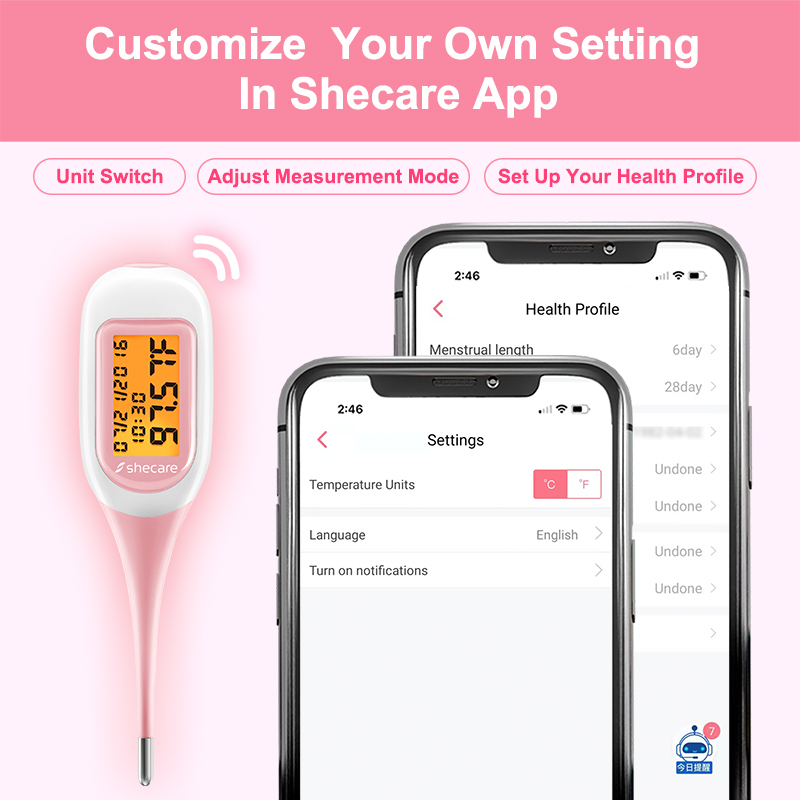When you have been trying to get pregnant for a period of time without success, you might as well try basal body temperature monitoring. Through it, you can not only monitor your ovulation day, but also learn about your ovulation, corpus luteum function status, whether you are pregnant or not, and an objective assessment of your fertility. After pregnancy, by monitoring the basal body temperature, the development of the fetus can also be assessed. Shecare is a professional digital thermometer manufacturer, contact us for more infomation about the thermometers!

First, let's talk about what is basal body temperature. Basal body temperature is the lowest body temperature that the human body reaches in a resting (usually sleeping) state, and it can reveal 6 health secrets to us.
1, with or without ovulation
For many women, the main purpose of monitoring basal body temperature is to find out the ovulation pattern and pinpoint the day of ovulation. So what do you think? In a menstrual cycle with ovulation, the basal body temperature will change with the menstrual cycle: with the ovulation day as the limit, the body temperature in the first half is low, usually 36.2 ℃ ~ 36.4 ℃, and the body temperature in the second half is high, which will rise by 0.3 ~ 0.6 ℃. Between the two halves of this period, there will be a minimum point of basal body temperature, and ovulation generally occurs in the period of rising basal body temperature after the minimum point. However, if the temperature curve does not rise significantly, it means that there is no ovulation, indicating that there may be: anovulatory functional uterine bleeding, infertility, polycystic ovary syndrome, premature ovarian failure and other abnormalities, reminding you to go to the hospital in time for medical treatment.
2. To guide conception
After knowing that "very low body temperature indicates ovulation", you can have intercourse on the same day and 1-2 days after, which can increase the chance of conception. Because the egg is released from the ovary, it can survive for about 1 to 2 days, and the sperm can survive in the female reproductive tract for about 2 to 3 days. However, it should be noted that the basal body temperature measurement in a single month cannot be used to guide conception. It is necessary to continuously monitor the basal body temperature for more than 3 cycles in order to accurately grasp the ovulation situation and ovulation pattern.
3. Understand the functions of corpus luteum and ovulation
If your basal body temperature rises rapidly from the low temperature phase to the high temperature phase, the high temperature is 0.2°C~0.5°C higher than the low temperature, the high temperature days are more than 11 days, and the body temperature in the high temperature area does not fluctuate violently, it means your luteal function normal. If the body temperature rises slowly after ovulation, or the temperature rise is less than 0.2°C, and the duration of the high temperature phase is less than 11 days, it indicates luteal insufficiency or luteal atrophy.
4. Prompt pregnancy
After the basal body temperature rises by 0.2 to 0.5 °C and lasts for more than 16 days, it indicates possible pregnancy; if it lasts for more than 20 days, the possibility of pregnancy is more than 98%.
5. Early warning of threatened abortion
In the early stages of pregnancy, if the body temperature fluctuates greatly and the basal body temperature has a saddle-type drop, it is an early warning signal of threatened abortion. It indicates that there may be signs of threatened abortion caused by luteal insufficiency and placental insufficiency. If treated in time, the body temperature will return. If the high temperature phase lasts for more than 20 days, but the curve fluctuates and there is vaginal bleeding, it may be a threatened abortion caused by luteal insufficiency, and progesterone can be used to protect the miscarriage. After treatment, the body temperature can return to normal. If the basal body temperature does not drop, but vaginal bleeding occurs, the possible reasons are: chromosomal abnormality, immunity, uterine malformation, etc., indicating that there is a problem with fetal development. In this case, progesterone is not recommended to protect the miscarriage.
At present, the more commonly used measurement method is: after waking up every morning, before speaking or doing any activity, measure the oral sublingual body temperature for 3 to 5 minutes. Continuous measurement of more than three menstrual cycles, the accuracy is relatively high. In order to minimize the error, it is necessary to put the thrown basal body thermometer bluetooth on the side of the bed or under the pillow every night before going to bed, so that it is easy to reach. At the same time, it should be noted that any factors that affect body temperature in life should be recorded on the watch. The current smart basal body thermometer is equipped with an App that can automatically upload basal body temperature data and automatically draw a basal body temperature curve, which is more convenient and faster than traditional basal body thermometers.
